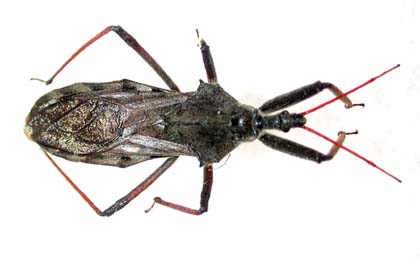
Insects with scleritized wings
 Scleritized
front wings, or tegmina (singular tegmen) are wings which have been hardened
into a protective sheath which cover the membranous hind wings. These
hard or leathery wings are not actually used in flight, but instead are
held out of the way of the hind wings. Scleritized wings are often
characteristic of mostly terrestrial insects, using flight as a secondary
means of movement. Because terrestrial insects come in contact more
often with materials that could tear membranous wings, the second layer
of protective material guards against this sort of thing.
Scleritized
front wings, or tegmina (singular tegmen) are wings which have been hardened
into a protective sheath which cover the membranous hind wings. These
hard or leathery wings are not actually used in flight, but instead are
held out of the way of the hind wings. Scleritized wings are often
characteristic of mostly terrestrial insects, using flight as a secondary
means of movement. Because terrestrial insects come in contact more
often with materials that could tear membranous wings, the second layer
of protective material guards against this sort of thing.

Beeltes, while they may not seem to have wings at all, do indeed have
functional wings. Beetle front wings are highly modified into "elytra",
effectively armor. The two "plates" of elytra meet right down the
center of the insect. A great example of beetle wings in flight are
june bugs. Often airborn at night in the summer, these beetles are
easily observed flying with their elytra held open and their membranous
hind wings working to keep the bugs aloft.

Hemipterans, or true bugs, have leathery front wings called tegmina
(singular tegmen). These wings cross over the bug's abdomen, giving
it the characteristic X across its back. Here again the membranous
hind wings are protected by the more durable layer of the tegmina.

Dermaptera (earwigs) have just what their name suggests: skin wings. The front pair of wings are small, leathery flaps. Under these are the hind pair which fold in complicated configurations to fit under the front tegmina. Since these bugs are mostly ground-dwelling, living under leaf matter and the like, it is very beneficial for them to protect their fragile wings.